A Traveler’s Guide to Fengdu Ghost City: Ghostly Adventures Await
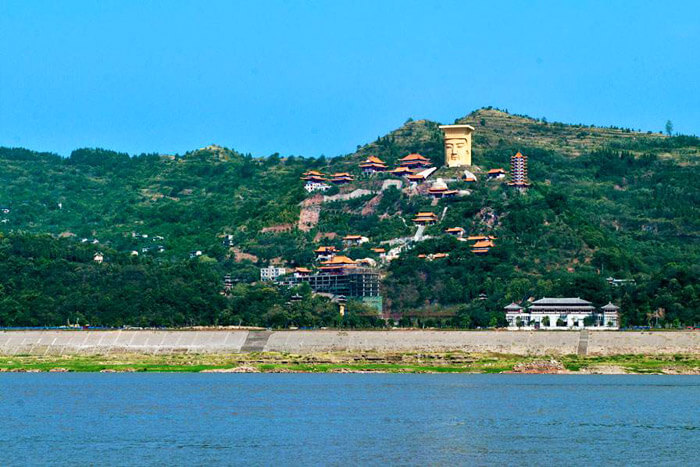
An Essential Guide to Visiting Fengdu_Ghost_City
Nestled on the northern banks of the mighty Yangtze River, Fengdu Ghost City, or Fengdu Ming Mountain Ghost City, is an extraordinary fusion of culture, spirituality, and folklore that beckons travelers with its otherworldly charm. Often referred to as the “Ghost City,” this enchanting site is steeped in stories of the afterlife, where ancient Chinese beliefs come alive amidst a labyrinth of temples, statues, and scenic vistas.
A visit to Fengdu is more than just a stroll through a historical park; it is an immersive experience into the intricate tapestry of Chinese ghost culture, where the past intertwines with the spiritual realm. As you traverse the steep paths lined with vibrant Taoist sculptures and eerie representations of the afterlife, you’ll find yourself captivated by the tales of the “King of Hell,” the revered Tianzi, and the trials souls face in the afterlife.
The journey begins with a climb that promises breathtaking views and a sense of adventure, whether you choose to ascend the numerous steps, take the scenic cable car, or stroll along the service road. Each route offers a unique perspective on this mystical site, leading you to the iconic Naihe Bridge, a symbolic passage to the underworld, where only the virtuous can cross unharmed.
Whether you’re a history buff, a cultural enthusiast, or simply in search of a unique experience, Fengdu Ghost City will leave an indelible mark on your travels, inviting you to ponder the mysteries of life, death, and the beliefs that shape our understanding of the afterlife. Prepare yourself for an unforgettable journey into the heart of Chinese spirituality, where every corner tells a story, and every step reveals a new facet of this ghostly wonderland.
In This Guide
- An Essential Guide to Visiting Fengdu_Ghost_City
- The Rich History and Legends of Fengdu_Ghost_City
- Main Highlights: What You Absolutely Can’t Miss
- Planning Your Visit: A Practical Guide
- Tickets: Prices, Booking, and Tips
- How to Get There: A Complete Transportation Guide
- Local Cuisine and Accommodation Nearby
- Frequently Asked Questions
- Final Thoughts on Your Trip
The Rich History and Legends of Fengdu_Ghost_City
Nestled on the banks of the Yangtze River in Chongqing, Fengdu Ghost City is a mesmerizing blend of history, spirituality, and folklore. This unique destination, often referred to as the “Ghost City,” has intrigued visitors for centuries with its rich tapestry of legends and cultural significance.
The origins of Fengdu Ghost City date back over 1,900 years, during the Han Dynasty, when two scholars, Yin and Wang, traveled to the area. They became Taoist recluses and are believed to have achieved immortality, hence the name “Yin Wang,” which translates to “King of Hell.” This connection to the afterlife is deeply embedded in the city’s identity, as it represents the intersection of Buddhism, Taoism, and Confucianism. The legends surrounding Yin and Wang laid the groundwork for what would evolve into a complex of temples and shrines dedicated to the underworld.
As you wander through the city, you will encounter numerous temples, statues, and intricate carvings that narrate tales of the afterlife. Among these, the Naihe Bridge stands out. Dating back to the Ming Dynasty, this bridge is often regarded as the passage to the underworld. According to local lore, only the virtuous can cross it unharmed, while the unworthy face peril, symbolizing moral judgment in the afterlife.
The architecture of Fengdu Ghost City is a visual feast, with over 27 temples, many adorned with vivid sculptures that depict the trials and tribulations of the soul in the afterlife. Visitors can glimpse the “Eighteen Levels of Hell,” where various punishments for the wicked are illustrated in dramatic detail. These depictions serve as both cautionary tales and reflections of the cultural beliefs surrounding morality and justice.
The site has been a pilgrimage for those seeking to understand the complexities of life and death in Chinese culture. Throughout the centuries, Fengdu Ghost City has evolved, with many structures being rebuilt or restored, particularly during the Tang and Ming Dynasties. Despite these changes, the essence of the city remains intact, inviting visitors to explore its haunted history and rich folklore.
Today, Fengdu Ghost City is not just a cultural heritage site but also a popular tourist attraction, accessible via a series of steep steps or a convenient cable car ride. As you navigate this eerie yet fascinating landscape, you may find yourself captivated by the stories of the ghostly figures that guard the gates of the afterlife, echoing the beliefs of generations past.
In a world where the past often fades into obscurity, Fengdu Ghost City stands as a testament to the enduring human fascination with the mysteries of life, death, and what lies beyond. Whether you’re an avid history buff or simply a curious traveler, this ghostly enclave offers a profound glimpse into the spiritual heart of Chinese culture.
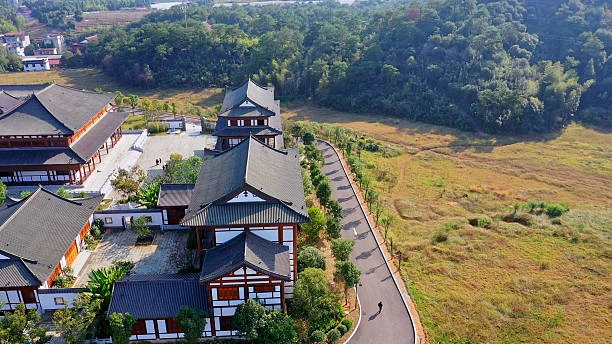
Fengdu_Ghost_City.
Main Highlights: What You Absolutely Can’t Miss
Fengdu Ghost City, known as 丰都鬼城, is a captivating destination located on the banks of the Yangtze River in Chongqing, China. This unique site offers a vivid glimpse into Chinese beliefs about the afterlife, making it a must-visit for international travelers seeking cultural depth and spiritual intrigue. Here are the main highlights that you absolutely cannot miss during your visit:
1. Naihe Bridge
Often referred to as the “Bridge to the Underworld,” Naihe Bridge dates back to the Ming Dynasty (1403-1424). This symbolic structure serves as a passage for souls, where only the virtuous can cross unscathed. The bridge is not just a remarkable architectural feature but also a powerful representation of Chinese folklore related to life and death.
2. The Temple Complex
At the heart of Fengdu Ghost City lies an extensive temple complex featuring over 27 temples, dedicated to various deities and spirits. The most notable is the Temple of the King of the Dead, dedicated to Tianzi. Here, visitors can explore intricate carvings and sculptures that depict scenes from hell, including demons and tortured souls, providing a haunting yet fascinating insight into ghost culture.
3. Cable Car Ride
For those looking to avoid the strenuous climb, the cable car offers a scenic and effortless ascent to the temples. The ride provides breathtaking views of the landscape and a unique perspective of the river below, making it an enjoyable experience in itself.
4. The 18 Arhats
As you wander through the city, be sure to observe the beautifully crafted statues of the 18 Arhats, each representing different aspects of Buddhist teachings. These figures are not only artistic marvels but also serve as reminders of the moral lessons that govern life and the afterlife in Chinese culture.
5. Creepy Statues and Abandoned Attractions
Beyond the main attractions, adventurous visitors can seek out hidden areas outside the paid park. These off-the-beaten-path spots feature eerie, abandoned statues and ghostly figurines that add to the mystique of Fengdu. Exploring these less frequented paths can yield unexpected treasures and a deeper connection to the site’s folklore.
6. Cultural Insights
Throughout your visit, take the time to engage with the rich history of Fengdu. The complex intertwines elements of Buddhism, Taoism, and Confucianism, providing a comprehensive look at how these philosophies coexist in the context of the afterlife. Guided tours often share fascinating stories and legends that enhance your understanding of this mystical place.
7. The Scenic Surroundings
Lastly, don’t forget to take a moment to appreciate the natural beauty surrounding Fengdu Ghost City. The misty mountains and the flowing Yangtze River create a striking backdrop, particularly enchanting during early morning or late afternoon light. This serene environment contrasts sharply with the intense themes of the ghost city, making for a well-rounded experience.
In summary, Fengdu Ghost City is a blend of awe-inspiring architecture, rich culture, and intriguing folklore. Whether you’re climbing the steps to the temples, riding the cable car, or exploring hidden corners, this destination promises an unforgettable journey into the realm of the afterlife. Make sure to include these highlights in your itinerary for a truly immersive visit.

Fengdu_Ghost_City.
Planning Your Visit: A Practical Guide
Planning Your Visit: A Practical Guide to Fengdu Ghost City
Fengdu Ghost City, located on the northern bank of the Yangtze River in Chongqing, is a mesmerizing cultural destination that delves into Chinese beliefs about the afterlife. Known for its intricate temples, mythological sculptures, and haunting ambiance, this site offers a unique experience that combines spirituality with stunning landscapes. Here’s everything you need to know to make the most of your visit.
Getting There
Location:
Fengdu Ghost City is situated approximately 170 kilometers from downtown Chongqing, making it a popular day trip destination.
Transportation Options:
– Cruise Ship: Many visitors arrive via Yangtze River cruises, which often stop at Fengdu. Be prepared for a short walk followed by climbing steps to reach the entrance.
– Bus/Taxi: If you’re coming from Chongqing city, you can take a bus or taxi. The journey will take around 1.5 to 2 hours, depending on traffic.
Opening Hours
Fengdu Ghost City is open daily from 6:30 AM to 5:30 PM. It’s advisable to arrive early to avoid crowds, especially during weekends and holidays.
Admission Fees
Before you enter, there will be an admission fee. Check the latest prices online or inquire at your accommodation, as fees may vary or change seasonally.
What to Expect
Physical Activity:
Prepare for a workout! The site requires navigating an initial 100+ steps, followed by options to ascend further:
– Steps: A total of about 500 steps to reach the main temples.
– Cable Car: For those wishing to avoid extensive climbing, a cable car is available, providing a scenic and less strenuous ascent.
– Service Road: Alternatively, you can walk up a service road that provides a gentler incline.
Attractions:
Fengdu Ghost City is home to over 27 temples and numerous statues that depict scenes from Chinese folklore concerning the afterlife. Key highlights include:
– Naihe Bridge: Known as the bridge to the underworld, where virtuous souls pass unharmed.
– Tianzi Temple: Dedicated to the King of the Dead, showcasing vivid depictions of hell and its denizens.
– Sculptures: Don’t miss the impressive and sometimes eerie sculptures that portray various ghostly figures.
Tips for Your Visit
- Wear Comfortable Shoes: Given the extensive walking and climbing, sturdy footwear is essential.
- Stay Hydrated: Bring water with you, especially if visiting during warmer months. There are limited refreshment options inside the complex.
- Consider Timing: The ambiance changes dramatically with weather. Fog can add an ethereal quality, but clear days offer better visibility of the stunning views.
- Explore Beyond the Main Attractions: Some visitors recommend seeking out hidden areas outside the paid park for a more adventurous experience. These spots can feature abandoned structures and intriguing photo opportunities.
- Cultural Sensitivity: Respect the local customs and beliefs associated with the site’s religious significance.
Nearby Amenities
After your exploration, you can find various dining options nearby. Local eateries serve traditional Chongqing cuisine, perfect for refueling after a day of adventure. Some recommended spots include:
– FengDu BinJiang MeiShiJie: A dining area with a variety of local and international dishes.
– HeBei BuXingJie: This vibrant street offers a selection of street food and small cafes.
Conclusion
A visit to Fengdu Ghost City is not just about witnessing its eerie charm, but also about immersing yourself in the rich tapestry of Chinese culture and mythology. Whether you’re drawn by the thrill of ghost stories or the allure of ancient temples, this destination promises a memorable experience. Prepare well, and enjoy your journey into the afterlife!
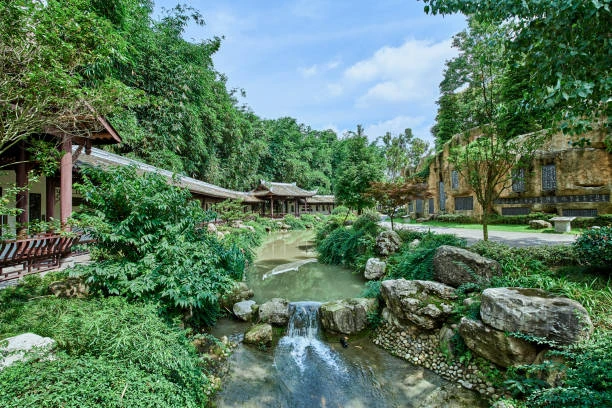
Fengdu_Ghost_City.
Tickets: Prices, Booking, and Tips
When planning your visit to the intriguing Fengdu Ghost City, it’s essential to know the ticketing details and some tips to enhance your experience.
Ticket Information
- Admission Fee: The standard ticket price for Fengdu Ghost City is approximately ¥70-¥100 (around $10-$15 USD), depending on the season and any ongoing promotions.
- Discounts: There are usually discounts available for students, seniors, and children, so be sure to carry the appropriate identification if you qualify.
- Purchase Options: Tickets can be purchased on-site at the entrance, or through various travel booking platforms and local travel agencies. Buying tickets in advance can save you time, especially during peak tourist seasons.
Opening Hours
Fengdu Ghost City is open daily from 6:30 AM to 5:30 PM. Arriving early can help you avoid the crowds and provide a more serene experience as you explore the complex.
Booking Tips
-
Plan Your Visit: Consider visiting on weekdays to enjoy a quieter atmosphere. Weekends and holidays can attract larger crowds, making it more challenging to navigate the site.
-
Consider the Cable Car: While there are multiple ways to ascend the site—walking approximately 500 steps, taking the service road, or opting for the cable car—the latter is highly recommended if you want to conserve your energy to explore the temples and statues.
-
Time Your Exploration: Expect to spend around 3-4 hours touring the site. This allows you to fully appreciate the elaborate sculptures, temples, and the unique culture surrounding the afterlife as depicted in Chinese folklore.
-
Be Prepared for Walking: Wear comfortable shoes as you will encounter a significant number of steps throughout your visit. If you have mobility concerns, the cable car is a great alternative to lessen the strain.
-
Explore Beyond the Paid Area: For the adventurous, consider seeking out the hidden, abandoned areas outside the paid park that some travelers have discovered. These spots can add an element of mystery and adventure to your visit.
By keeping these tips in mind and planning ahead, your visit to Fengdu Ghost City promises to be an unforgettable journey into the realm of the afterlife. Enjoy the haunting beauty and rich cultural tapestry that this extraordinary site has to offer!
How to Get There: A Complete Transportation Guide
Getting to Fengdu Ghost City, a fascinating blend of culture and mythology located along the banks of the Yangtze River in Chongqing, is an adventure in itself. Here’s a comprehensive guide to help you navigate your way to this unique destination.
Arriving in Chongqing
Before heading to Fengdu Ghost City, you’ll want to reach Chongqing, which is well-connected via various modes of transportation.
By Air
Chongqing Jiangbei International Airport (CKG) is the primary airport serving the city, with numerous domestic and international flights. From the airport, you can take a taxi, airport shuttle, or use ride-hailing apps to reach downtown Chongqing.
By Train
Chongqing has several major train stations, including Chongqing North Railway Station and Chongqing Railway Station. High-speed trains connect Chongqing with major cities like Beijing, Shanghai, and Guangzhou. Upon arrival, you can use local taxis or public transit to reach your next destination.
By Bus
Long-distance buses operate from various cities to Chongqing. The main bus terminals are located close to the city center, making it easy to transfer to other modes of transportation.
Getting to Fengdu Ghost City
Once you’re in Chongqing, there are several options to reach Fengdu Ghost City, located about 170 kilometers (approximately 105 miles) from the city center.
By Car or Taxi
The most straightforward way to reach Fengdu Ghost City is by taxi or private car. The journey typically takes around 2 to 3 hours, depending on traffic. You can pre-book a taxi or arrange a rental car through various services available in Chongqing.
By Public Bus
For a more economical option, take a bus from Chongqing’s main bus stations, such as the Chongqing Long-distance Bus Station. Buses to Fengdu depart frequently, and the journey takes about 2.5 to 3 hours. Make sure to check the bus schedules ahead of time, as they can vary.
By Cruise
Another unique way to approach Fengdu Ghost City is via a river cruise. Many cruises along the Yangtze River stop at Fengdu, allowing you to enjoy the scenic landscapes while traveling. Be prepared for some climbing, as most cruises will drop you at a point from which you will need to ascend to reach the entrance of the Ghost City.
Arriving at Fengdu Ghost City
Once you arrive at the site, there are several ways to navigate the terrain, which includes a number of steps and ascents.
Entrance and Climbing
The entrance to Fengdu Ghost City is marked, and visitors typically need to ascend approximately 100 steps to reach the main area. From there, you have a few options:
-
Cable Car: For those looking to avoid strenuous climbing, the cable car is a popular choice. It offers a scenic ride up to the temple area, providing stunning views of the surroundings.
-
Service Road: If you prefer to walk, you can opt for the service road that winds its way up to the temple complex. This route is less steep than climbing the stairs directly, making it a good alternative for those looking for a more gradual ascent.
-
Steps: For the adventurous, there are about 500 steps to climb to explore the full extent of the Ghost City. It’s advisable to wear comfortable shoes and take your time, especially if you’re not used to such physical exertion.
Conclusion
Reaching Fengdu Ghost City is an integral part of the experience, as the journey allows you to soak in the lush landscapes and intriguing culture of the region. Whether you choose to travel by car, bus, or cruise, your adventure to this ghostly realm will be filled with stories and sights that are sure to leave a lasting impression. Prepare for a blend of history, mythology, and breathtaking scenery as you step into the world of Fengdu Ghost City.
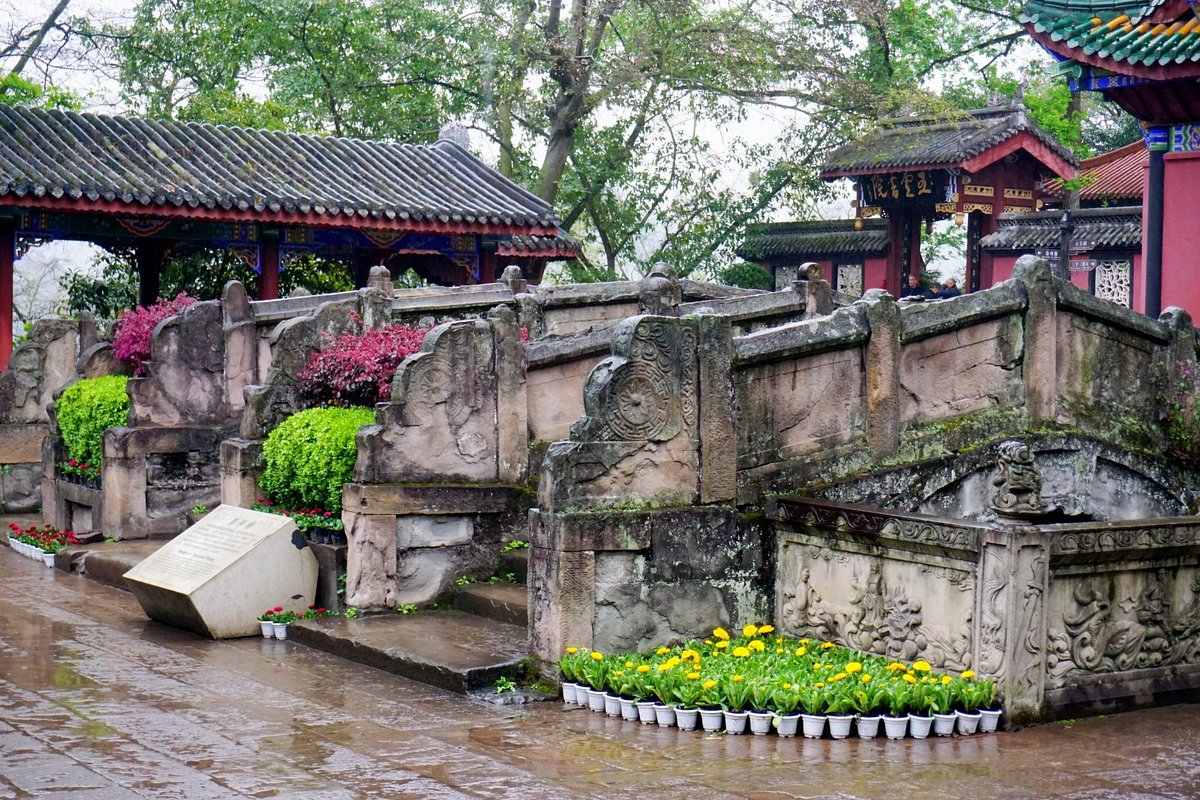
Fengdu_Ghost_City.
Local Cuisine and Accommodation Nearby
When you visit Fengdu Ghost City, immerse yourself not only in its intriguing culture and history but also in the local flavors and comfortable accommodations nearby. Here’s a guide to enhance your experience.
Local Cuisine
1. Fengdu Binjiang Meishi Jie (丰都滨江美食街)
Just a 10-minute drive from the Ghost City, this food street offers a vibrant array of local delicacies. Be sure to try spicy hotpot, a Chongqing specialty, featuring fresh ingredients cooked right at your table in a bubbling pot of flavorful broth. For something sweet, don’t miss the sugar-coated hawthorn berries—a popular snack that balances the heat of the hotpot perfectly.
2. Chongqing Noodles (重庆小面)
A staple dish that can be found in many local restaurants, you’ll want to taste these spicy noodles topped with scallions and peanuts, offering a satisfying kick. Many eateries near the Ghost City serve this dish, making it an easy and delicious option after your explorations.
3. Traditional Tea Houses
Experience the local tea culture by visiting one of the nearby tea houses. Sip on Chrysanthemum tea or Pu-erh tea while enjoying the serene atmosphere. This is a great way to relax and reflect on your visit to the Ghost City.
Accommodation Options
1. Fengdu International Hotel (丰都国际大酒店)
Located approximately 15 minutes from Fengdu Ghost City, this hotel offers comfortable rooms with modern amenities. It’s perfect for those seeking a relaxing stay after a day of hiking up the temple complex. The hotel also has a restaurant that serves both local and international cuisine.
2. Jinjiang Inn Fengdu (锦江之星丰都店)
For budget travelers, Jinjiang Inn provides clean and simple accommodations without sacrificing comfort. Located close to the main attractions, it’s an excellent choice for those who want to explore the area without overspending.
3. Fengdu Zhonghe Hotel (丰都中和酒店)
This mid-range option offers a cozy atmosphere with a range of services including restaurant dining and tour assistance. Its proximity to both the Ghost City and local eateries makes it an ideal base for your adventures.
With these culinary delights and cozy accommodations, your visit to Fengdu Ghost City will be both enriching and enjoyable. Whether sampling the local cuisine or relaxing at your chosen hotel, you’ll find a warm welcome in this hauntingly beautiful region.
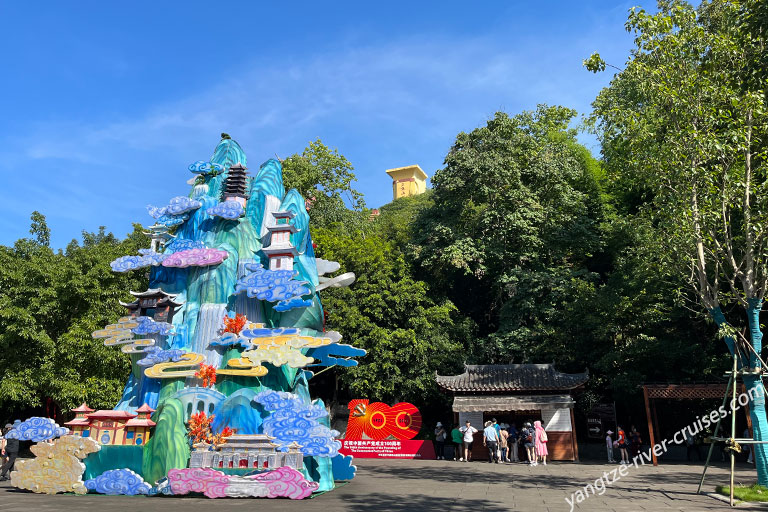
Fengdu_Ghost_City.
Frequently Asked Questions
Frequently Asked Questions about Fengdu Ghost City
-
What are the opening hours for Fengdu Ghost City?
Fengdu Ghost City is open daily from 6:30 AM to 5:30 PM. Make sure to plan your visit accordingly to explore the site fully! -
How do I get to Fengdu Ghost City from Chongqing?
You can reach Fengdu Ghost City by taking a taxi or public transportation from downtown Chongqing. If you’re coming via cruise, the port is nearby, and you’ll need to climb some steps to reach the entrance. -
Is there a lot of walking involved?
Yes, be prepared for a fair amount of walking and climbing. After an initial ascent of about 100 steps, you can either take approximately 500 more steps, use the service road, or opt for a cable car to reach the temple complex. -
Are there facilities like restrooms and food available?
Yes, there are restrooms and food options available within the park. However, it’s advisable to bring water and snacks, especially if you plan to explore extensively. -
What is the cultural significance of Fengdu Ghost City?
Fengdu Ghost City is steeped in Chinese folklore and mythology, representing the afterlife and ghost culture. The site features over 27 temples, statues, and shrines that reflect beliefs from Buddhism, Taoism, and Confucianism. -
Can I take photos inside the park?
Yes, photography is generally allowed throughout Fengdu Ghost City. However, be respectful of the cultural and religious significance of certain areas and be mindful of other visitors. -
Is it suitable for families with children?
Fengdu Ghost City can be an interesting visit for families, but the extensive climbing may be challenging for younger children or those with mobility issues. Consider using the cable car to make the visit easier. -
What should I wear when visiting Fengdu Ghost City?
It’s best to wear comfortable walking shoes, as you’ll be navigating many steps and uneven terrain. Dress in layers, as the weather can vary, particularly in the mountainous regions.
Final Thoughts on Your Trip
As you conclude your exploration of Fengdu Ghost City, take a moment to reflect on the unique tapestry of culture, history, and mythology you’ve encountered. This ethereal site, steeped in tales of the afterlife and adorned with mesmerizing sculptures, offers an unforgettable glimpse into Chinese beliefs surrounding fate and the spirit world.
Whether you opted for the invigorating climb up the steps or the scenic cable car ride, each path leads to the same awe-inspiring temples and statues that have withstood the test of time. The juxtaposition of vibrant artistry and the haunting narratives they illustrate creates an atmosphere that is both captivating and thought-provoking.
Fengdu Ghost City is more than just a tourist destination; it’s a journey into the soul of a culture that reveres the past and contemplates the mysteries of what lies beyond. As you leave this remarkable site, carry with you the stories of Yin and Wang, the vibrant statues, and the echoes of ancient beliefs—a reminder of the beauty found in both life and the afterlife. Safe travels, and may your next adventure be just as enriching!